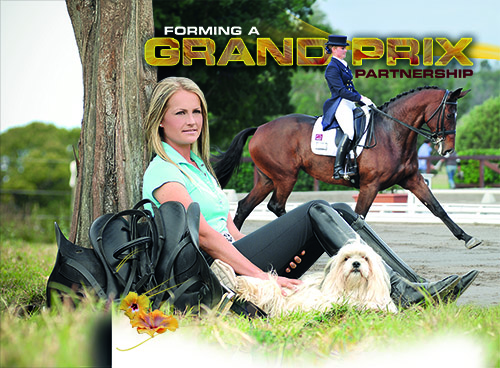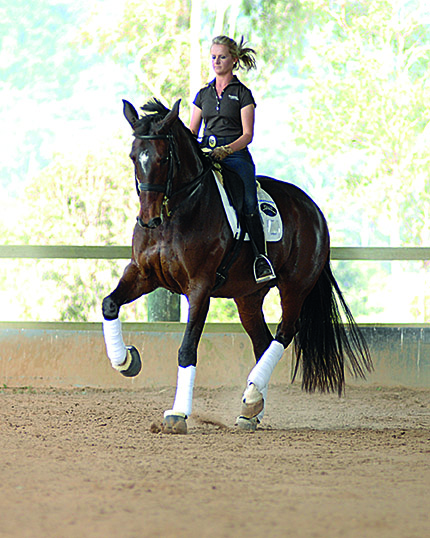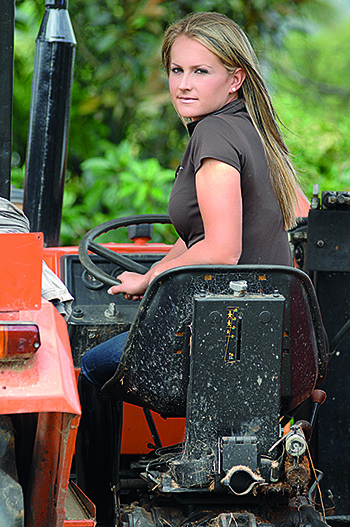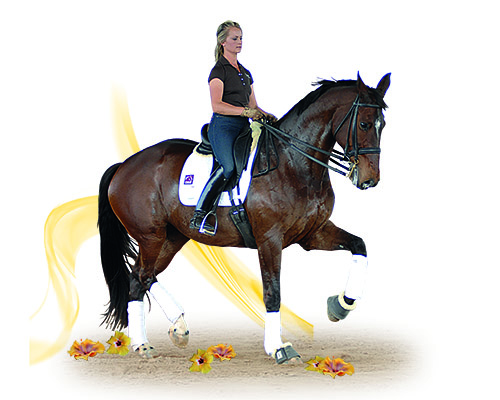Story – Shannan Makauskas & Photos – Alex Makauskas
The first day of spring set the perfect backdrop for our photo shoot with a budding talent on the Grand Prix circuit, Emma Flavelle.
On the outskirts of the Sunshine Coast in Queensland we stepped out of the car and into the taste and smell of sunshine in the air, new life bursting from the ground, the sounds and smells of a spring morning. But never mind all that, while I admired the scenery, poor Emma Flavelle was completely out of her comfort zone.
We had hired a hair and make-up artist to prep her for our photo shoot, and while the photos show a beautiful character ready for the latest Saddle Club installment, the real story involves scoping for locations around the property and putting Emma in place with a rigorous checklist: breeches zipped, dog on lap, hair blowing in wind, etc. For all the result was darn near perfect, it really wasn’t Emma’s thing, and it was only when she finally able to get on her horse and take to the arena, that the poor girl breathed a sigh of relief.
Northern Meara is this monstrous 17.1hh mare, while Emma is a petite and elegant rider, making them look like the most unlikely pair. Nevertheless, when you put Emma in the saddle, these details become irrelevant.
They go together with a familiarity that comes from a partnership developed over ten years. When Emma was 16 years old she had her first ride on the four year old, ‘Big, lanky, all over the place mare’:
“I got on and she was charging around the arena. So I brought her back and straight away she offered these amazing half steps. I thought, ‘Wow this is going to be a fun horse’.”
At the time Emma was working at the dressage stables of Linda Schmerglatt and making some big decisions: “I was doing a Diploma in Business, but from the time I started working at Linda’s I thought, ‘Yeah this is what I want to do.’ I hated an office, I hated doing business because I always wanted to be outside.”
She was also making some changes with her riding: “I decided I wasn’t good enough at jumping and I just like the technical aspect of dressage. I really thought that I could get somewhere with it. I was comfortable doing it. I liked it. I thought, ‘Okay to be serious I need to specialise’, and I made the decision.”
The choice to stick with dressage was influenced by her mentor, Linda Schmerglatt: “When I was working there she had Fenton. I only got to see him a couple of times but I remember it vividly, that horse, he was very inspirational. Seeing them working together, I just wanted to be as good as that.”
When I watch Emma ride, the similarities between her and Linda jump out at me. As well as a likeness in physical traits they both posses an elegance and natural ‘feel’ in the saddle that can’t be taught.
This is a trait Emma admires in another influential figure from her riding career, German National Young Rider Coach, Hans Heinrich Meyer zu Strohen. On her first trip to Germany at 19 years of age Emma based at his stable for six months:
“He was the most feeling rider I think I’ve ever seen, just amazing to watch. You could learn so much just from watching him ride and I think to ride with that much feeling and that much…I can’t even describe it. Just watching him and wanting to be able to ride like him, it was so inspirational and it made all the difference.”
Emma formed a good relationship with Hans Heinrich and it paid off when she got to ride the now deceased legendary young horse, Poetin: “She was, it is my most vivid memory, the best thing ever, she was amazing.”
“I got to ride her three times. Either Hans Heinrich thought I was good enough to ride her or maybe he was just being nice. Her weakness was the walk, so besides working in the arena I would walk her out around the roads to try and improve the walk.”
“To ride a horse of that calibre was amazing. I also got to work Kaiserdom, who won the six-year-old Bundeschampionate and the World Young Horse Championships. But Poetin is an unforgettable horse.”
Perhaps Emma could get a ride on Poetin Z someday, her clone: “I read about that, it’s a bit freaky, it’s too much I think.”
Her first trip was to get a feel for the scene in Germany: “I wanted to see what it was like, what I was in for, what opportunities there were. I knew I wanted to take two horses on my next trip and that it was going to be difficult. I just needed to know I could do it, and be able to move around if I needed to. I wanted to go and learn the ropes.”
Two years later, when she was 21 years old, she made the leap and based in Germany for three years. This time taking her own horse, Northern Meara, and a young horse owned by Lorraine Gough, Exklusiven Armani. A pretty daunting experience for a young rider:
“I didn’t think about it at the time. I was just like, ‘Oh yeah that’s what I’m going to do, no problem.’ Now when I look back on it, yeah it was quite a big thing. It could’ve been disastrous, but I never thought about it and luckily everything went well.”
So what were the challenges? Surprisingly, it wasn’t the workload: “The hardest thing for me was the winter. I feel the cold incredibly and I just hate it. The work was fine because I’m pretty disciplined with what I do at home. Obviously the language, in the beginning, was hard. But you pick up on that and most of them speak English so you can get by.”
A lot of young riders go to Europe to train and end up cleaning boxes all day…
“Well two of the stables I was at, employed somebody to do it, so we didn’t have that problem. Then at Jörn Kubelke’s place they only cleaned the boxes every six weeks.”
Every six weeks! “That would get a bit stinky,” I said.
“Well it doesn’t actually,” said Emma.
“Maybe you just got used to it?”
“Well maybe that’s it…yeah,” Emma laughed. “We would add straw every morning on top and it would build up and up and up and then we’d have a hard time digging it all out. It keeps them warm in winter though, the build up. But they get a lot of foot problems there.”
So we’d suggest a five-week training stint if you’re going to Jörn Kubelke’s… besides this revolutionary stable routine, did Emma learn a lot from Jörn?
“Um…yes,” said Emma hesitantly with a cheeky grin on her face, “That probably wasn’t my best experience, what can I say? I was there for eight months but Jörn didn’t have the quality of horses that other places had. You are constantly learning from every place you go, picking up ideas from every trainer and at Jörn’s it was no different. I just felt a lot more restricted in my opportunities at that particular stable.”
From there, Emma went to work at the stables of Danish Royalty: “It was awesome to work for Princess Nathalie (zu Sayn-Wittgenstein-Berleburg). It was nice to be able to ride there because they had these amazing gardens. After doing arena work in the morning the horses would be taken out through the botanic gardens for the afternoon, it was lovely.”
Princess Nathalie has given many clinics throughout Australia and riders are always surprised to find she doesn’t fit the ‘princess’ stereotype: “She was strict, but she was very lovely at the same time so it didn’t feel like you were under the whip or anything. She was really lovely and it was a very good atmosphere there.”
“Her training method is very classical, very empathetic towards the horses, her way is brilliant. I picked up a lot from her. She was a real mentor to me and just a lovely person, very down to earth and loved the horses, it was great.”
A year ago Emma went back to Germany, this time basing with Isabell Werth’s trainer Wolfram Wittig: “That trip was just a touch up to get my eye back in, have a few lessons and see some brilliant horses again. It was organised through Robert Schmerglatt because he was training with Wolfram at the time. I got on really well with Wolfram and his facility is just awesome.”
Was it always the plan to try so many different trainers? “It was always my plan, I wanted to pick up on a few different ideas, a few different styles of riding while I was there and obviously you can learn from everyone. I picked up different ideas at different places.”
Is that what you’ve got now, your own system with a little from each trainer? “I hope so. It works for me and I’ve picked up the things I thought worked well for them and what I can do myself as a rider. Because I’m obviously no Hans Heinrich, I’m no Princess Nathalie, but from working with them I’ve picked up some ideas.”
Did they all use very different methods? “Generally not, generally they all worked on the training scale. But different exercises they had worked for different things and it’s good seeing a few places to get a good idea.”
If there’s anything Emma’s time overseas taught her, it’s that dressage is the sport of discipline. She advises aspiring travelers to be prepared: “Always be wanting to do something. Always ask, ‘What can I do now?’ Just be very motivated, very keen, very much wanting to be there and wanting to do your best. The attitude must be in order.”
It’s a matter of making the most of the time you’re there: “I learnt to do everything a hundred percent. Every time you ride, do it to a hundred percent of your ability.”
“At each stable I was riding between seven and ten, even twelve horses a day and you can’t slack off. Generally you start at 7am and finish at 6 in the evening, sometimes a lot later, but each stable had a different system.”
Do you have a trainer who helps you in Australia? “I go to Linda when I can, and back to Germany. I’m going to go there once a year. Financially it’s not so easy sometimes. But you’ve got to do it if you want to be good at this sport.”
Do you ever find you get a bit off-track? “You do. I was just with Carlos de Cleermaecker at the squad clinic and he pulled me up on a few things I realised I’ve let slip. That’s why they’re so good in Europe, they’ve constantly got somebody there.”
In comparison to Australia, what was the most striking difference in the dressage scene? “It’s just very professional, just ultimate professionalism. Every show has this amazing atmosphere and the prize giving ceremonies have this great music for every presentation.”
“They’re all mounted, and there’s big crowds, and they have these awesome lolly shops at every single show. They have every single lolly you could ever want,” she said with her face lighting up at the mere memory of it.
Besides going over for the lollies, Emma thinks it’s worthwhile taking a horse with you: “For me it was. I could put what I saw and what I learnt into my own project, and for me that was important. It kept me motivated, and wanting to be there.”
“It was all worthwhile to be able to put it into my own horse to take back with me because you’re busting your boiler everyday riding ten horses to the best of your ability and you want to be able to put that into your own piece of work.”
The resultant piece of work was dancing in front of me in the form of Northern Meara. Emma began the session with a lot of walking and talking and Meara was showing her quiet side. If you’ve seen Emma compete this electric mare at competition you may be asking, ‘What quiet side?’
In this case it turns out the saying, ‘Things aren’t always what they seem’, is true: “They’re horses and you might see something, but what’s going on in the horse’s mind is something totally different. A lot of people come up to me and say, ‘Oh she’s so hot. She’s a really hot, tense horse.’”
“When in fact she isn’t, she’s such a quiet horse. My nieces and nephews walk her around the arena or in the field on a long rein and she never puts a foot wrong. You’ll see in the first ten, fifteen minutes of riding that she’s so lazy. She’s not this hot, crazy horse. She’s got a beautiful temperament. She’s very gentle and very calm. It’s just those moments when she gets worried that make her come across that way.”
Having trained the talented mare from a four year old to her first Grand Prix dressage horse is quite a milestone: “She wasn’t the easiest horse and still isn’t the easiest horse. But to be able to achieve that is a great feeling and it was one of my goals in life.”
Emma remembers their first Grand Prix test, an unofficial competition on the Sunshine Coast at the end of 2008: “It was very overwhelming. Everything comes up so quickly it’s bang, bang, bang. You don’t have a lot of time to think in the test about what you’re feeling but after it I felt great.”
Compare that to her ride in the Grand Prix at the Australian Dressage Championships last year. Emma made quite an impression, even receiving a standing ovation from the crowd: “That was very emotional. I remember in the test being very emotional. I had time to think how I was feeling because everything was just flowing and it was a good feeling.”
Since then Emma has been working on the difficult parts of the test for Meara: “There are a few issues to overcome at the moment. She gets worried on the centreline for some reason. She knows the test and she knows the last centreline is passage, piaffe, passage.”
“Her piaffe and passage are her strong points and she’s quite comfortable in them, but for some reason that last tour makes her worried. She gets insecure, so we’ve got to go back to fix it.”
“I’ve done everything I can in the classical way to try and fix the problem, so now I’ve got to think outside the square and see what else I can do. Maybe some clicker training will work – I started with her yesterday.”
As is often the case, great horses take time: “She tries too hard and it gets all too much for her. She over-tries all the time, which is great in some ways. She lowers so much behind that she actually loses balance. At least I’m never going to have the problem where the piaffe is not good enough. I don’t need to worry about that, I’ve just got to worry about trying to keep her mind relaxed and willing.”
With Emma working on building Meara’s strength and consistency in the test, she knows her biggest hurdle is keeping her state of mind. But with almost two years of Grand Prix competition under her belt, will the mare ever turn the corner?
“I do think about that, you’ve always got to look forward and be optimistic and if something’s not working, try something else. She’s definitely worth every single bit of effort. I think I can do it. It’s just a matter of time.”
“She’s definitely got a lot of miles left in her. That’s another thing I learnt in Germany, you don’t ride everyday with so much power. You don’t ride the big trot everyday. You just work on the basics and every now and then you bring out that top gear. I do that at home all the time, because I’m very conscious of keeping the soundness right.”
Emma is setting her sights on the London Olympics in 2012 but realises it’s a long, tough road to get there: “I just want to know that I’ve done my best to achieve what I can. I’m not going to say, ‘I want to compete at the Olympics or win medals’, because there’re lots of variables. There’re lots of things that could or could not go wrong. At the end of the day I just want to know I’ve done the best I can.”
To add to the dilemma, Emma feels there needs to be an outdoor qualifier in Australia: “I’ve got a bit of a problem with the fact that in Australia they don’t have a freestyle competition or a qualifying competition that is run in conjunction with the conditions they have at WEG or the Olympic Games. Why not have the freestyle outside? Why does it have to be for everyone’s entertainment rather than the welfare of the horse?”
The selection process can also get very political… “It is everywhere you go. You can’t get away from that part of the sport. But I want to know that I’ve done everything I possibly can for that horse to get her there and I will regret it if I don’t do everything I can.”
The plan involves taking Meara over to Germany next year to base with Wolfram Wittig or Hans Heinrich Meyer zu Strohen. But with big schemes come big sacrifices: “We’ll see financially how things are going. I’ll have to sell a few horses.”
“I don’t want to go over there and work full time because I found after riding ten horses, you can’t put as much into your own horse at the end of the day. I’d like to go over and maybe work half a day, just to cover expenses like Meara’s keep and my board.”
Do you think it’s easier to qualify overseas? “I’m undecided about that at the moment. I would go over for the consistency in training, the constant help you get and the raised level, being able to see and surround yourself with all the amazing horses and riders and really push yourself.”
In the end that’s what it all comes down to. We are in a sport that is a way of life and requires many sacrifices. With little hope of ever making it to the medal podium, riders go on. Quietly working away at achieving greatness.
Whether that lies in producing a harmonious test, a brilliant piaffe or a line of ones without it all falling apart, the goal is different for every rider and yet the same, to be one with the horse. Hopefully this promising combination will get to represent their country, but that would be the icing on the cake after the all the beautiful moments Meara has given Emma.





